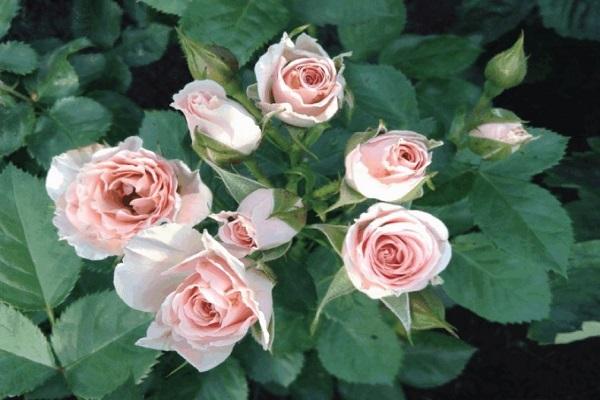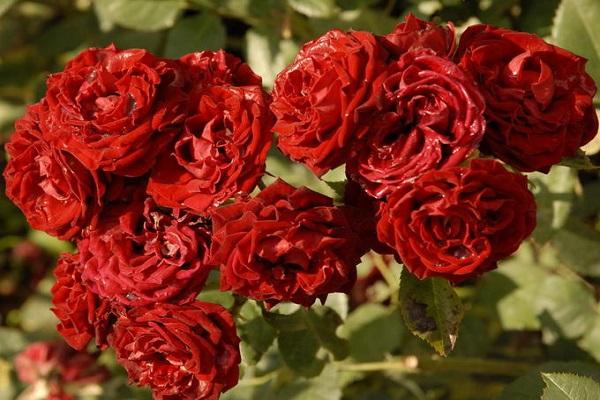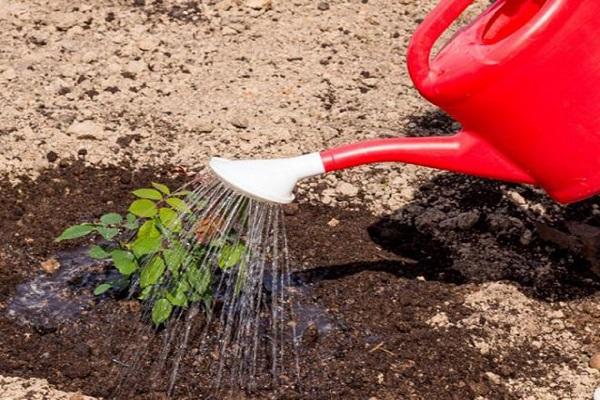Description of varieties of roses Spray, planting and care in the open field for beginners
Spray roses have recently appeared on the flower market. Florists create chic bouquets from them, especially for weddings. Flowers do not require painstaking care, they are easy to grow even for a novice gardener. To create a romantic atmosphere on your site to the envy of neighbors, you should familiarize yourself with all the features of the subspecies, the subtleties of planting and supervision.
Content
Description of culture
Spray roses are a group of subspecies similar to floribunda. Their distinctive feature is the short stature of the shrubs. They reach up to about 60 centimeters. The flowers are tiny, beautiful, from 3 to 7 cm in diameter. There are 10-15 buds on one branch. They bloom evenly, one shoot is a complete bouquet. In floristry, flowers are used not only to create wedding bunches, but also as a background for larger crops in complex compositions.
Most Popular Patio Rose Varieties
There is an abundance of varieties of the Spray Rosaceae family. They differ in color and color. The method of planting and leaving is the same. The difference lies in the price. It is advisable to buy seedlings from trusted sellers or in specialized stores, so as not to run into a wild-growing seedling or a rose of another variety. The varieties listed below tolerate frost normally, which plays into the hands of the inhabitants of the CIS countries. Also, the bushes are not afraid of pests, diseases, if you take care of them properly.

Pink and cream
The pinkish and creamy Patio roses are divided into the following varieties.
- Cherry Folies. It is a shrub of compact size, graceful shape. A shade of lilac with a white undertone. The variety takes root well in middle and northern latitudes.
- Orion. This attractive bush is famous for its large, delicate lavender flowers. The variety blooms for a long time, resistant to frost.
- Tiramisu. Roses are terracotta-raspberry color, inside the shade turns into a lighter one. The variety is unpretentious in care.
In addition to the basic colors, roses are found in marvelous colors. These varieties include Hocus Pocus. The petals are colored with purple and bright yellow stripes. The floral mix creates a brindle color. White varieties are no less charming, they can be an independent element in the garden. Among these flowers, the varieties Kent, Princess are distinguished.

Yellow and orange
Yellow miniature roses enchant with exotic beauty and have a wide range of combinations in landscape design.
- Sphinx. They are bright yellow roses with a mild aroma.Shrubs with large flowers of a rich yellow color grow up to 60 centimeters. The subspecies is resistant to changeable weather.
- Fire Flash. Such a representative of the Rosaceae family has a bright yellow color, closer to orange. The petals are colored to the end in a coral color, the color resembles a brindle. The flowers are about 4 centimeters in diameter.
- Zorenka. The rose is yellow-red, a spectacular bush, with dense double inflorescences. The petals shimmer from yellow to crimson. The shrub grows up to 70 cm high. Blooms until the end of November.
The listed subspecies of yellow spray roses fit into any flower arrangements, the shade perfectly dilutes the pinkish-red, classic range.

Red
Scarlet spray roses should be in every garden. They make bouquets for any occasion, the red tint symbolizes passion, personifies love.
- Tamango. Shrub up to 60 cm in height, 70 cm in diameter. The subspecies is compact in size, abundant, long flowering. Velvet flowers are quite large, about 7 centimeters in diameter. They are composed of many petals. On one branch there are up to 10 scarlet inflorescences with crimson color. The rose grows well both in the sun and in the shade.
- Natalie. The decorative subspecies grows no more than 70 cm high. The bush is compact, blooming profusely. Small flowers, up to 5 centimeters in diameter, with a subtle scent. The color of the roses is red.
- Mikado. The rose is dark scarlet, with double goblet flowers. The shrub is compact, up to 70 cm high, with spreading shoots and abundant pollen. Up to 6 buds can grow on one cyst.
Red varieties look harmoniously on borders, in the foreground in flower beds.

Others
There are also a number of varieties of different shades.
- Paple Tiger. The subspecies is one of the most extravagant, the flowers are densely doubled, of a unique purple-lilac color with white strokes and spots. One cluster has up to 5 flowers, about 6 cm in diameter. Flowering is long, often the bush blooms again. Shrubs grow up to 70 cm high. Light aroma with hints of musk. The subspecies is widely used for decorating borders, decorating flower beds.
- A droplet. Spray rose grows up to 60 cm high. The culture takes root well in garden plots, suitable for edging paths, growing in containers, on balconies. The color is varied: red, pinkish, purple.
- Kent. It is a compact shrub, covered with a mass of snow-white flowers. The plant grows up to 60 cm in height and width. Blooms before the first frost.
The above types are the most popular in recent years on the territory of the countries of the former USSR and abroad.

Landing subtleties
Planting a rose is easy, the main thing is to follow the instructions. Choose an illuminated location that is protected from wind gusts. Some subspecies fade in the sun, partial shade is quite suitable. To plant a flower, you will need to perform the following actions:
- dig a hole 45 * 45;
- at the base of the hole there should be a drainage layer of pebbles, sand;
- put organic fertilizing over the drainage - dry foliage, humus, manure, rot;
- plant a plant in a hole, cover with open ground and tamp a little against the stems;
At the end, pour with settled water, with the calculation of 8 liters per bush.

The nuances of care
From March to July, apply top dressing with a high content of nitrogenous substances. In summer and until autumn, add potassium and phosphorus. It is important to carry out feedings during budding and at the end of pollen. Loosen the soil around the shrub regularly. For the winter, cover the plant. In the heat, it is worth sprinkling the petals with water, but towards evening, when the sun goes down.
Watering
Water the miniature roses Spray in the same way as other Rosaceae varieties. Pour water under the root so that it does not fall on the leaves. Begin irrigation when the ground dries out from the previous watering.One bush will need 8 liters of water.
Ice liquid cannot be used, it must be at room temperature. After that, weed the soil so that there are no crusts.
Top dressing
It is advisable to periodically fertilize roses. Feeding is especially required during budding and color. The procedure is carried out according to the general rules:

- during the appearance of buds;
- at the end of summer.
Roses love nitrogen fertilizers. By autumn, add potassium-phosphorus compositions. You can buy ready-made mixtures in the store, dilute them according to the instructions.
Wintering
Before frost, at about the beginning of October, cut the rose bushes to a height of 30-40 cm. Remove leaves, buds, flowers from them with soil up to 30 cm up. Needles are placed on top, covered with burlap. If the roses are covered with snow, don't worry. This will serve as additional shelter, give them moisture.
How and when to trim
It is necessary to prune shrubs in order to activate the formation of young shoots, long flowering. Prune 2-3 times during the growing season. Eliminate damaged and dry branches in parallel. At the end of flowering, remove the wilted flowers. Shorten the bush in June so that the rose does not expend energy on the formation of fruits, the bloom is more intense. Pruning will serve as an excellent prevention of fungal infections.

Diseases and pests
Rose Patio is rarely affected by pests and diseases, but if an attack occurs, it is important to take sanitary measures.
- A soap solution with mustard powder helps with aphids. They also use the chemicals Aktellik, Rogor, Karbofos.
- The cicadac is eliminated using chemicals, insecticides.
- The spider mite is excreted by Vermithek or Fitoverm.
- The leafworm is removed with insecticides.
- Powdery mildew is removed by spraying the plant with a solution of soda ash 0.5%.
- They fight black spot by treating the bush with Bordeaux liquid. If the lesion is severe, the rose is burned.
Competently carried out pruning, soil fertilization, will help to avoid attacks of pests and diseases.

How to propagate Spray roses
A miniature rose is propagated by seeds, cuttings, dividing and rooting. The result can be unpredictable, therefore, it is better not for gardeners without experience in growing flowers.
Patio rose does not reproduce well by seeds, from which another flower can grow. The easiest way is to resort to dividing the bush. Thanks to this technique, a ready-made, adult plant is obtained. This is stress for the mother's rose, she loses her immunity. Flowering can be scarce, growth is suspended. It also takes a lot of rooting time.

Use in landscape design
Multi-flowered roses are a godsend in landscape design. They look gorgeous in regular style gardens. The brightness of flowers is emphasized by group plantings and trimmed borders.
You can plant roses next to perennial grasses, lavender, cornflowers, bush crops. Choose the color at your discretion.









